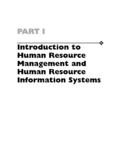Transcription of Polio and the Introduction of IPV - World Health …
1 Polio and the Introduction of IPV Poliomyelitis ( Polio ) is a highly infectious disease that is caused when a person is infected by the Polio virus that invades the nervous system. Poliomyelitis can cause paralysis and even death. There are 3 types of the Polio virus type 1, type 2, and type 3. The Polio virus usually affects children under 5 years of age who are not fully vaccinated. It can also affect adolescents and adults. The Polio virus enters the body through the mouth when one eats food or drinks water that is contaminated with faecal matter from a person who carries the Polio virus. The virus multiplies in the intestines and is passed through faeces. The symptoms of Polio are fever, fatigue, headache, vomiting, stiffness in the neck, pain in the limbs, and weakness in the limbs. If a child under 15 years of age suddenly shows signs of a floppy or weak arm or leg, then Health authorities should be informed immediately.
2 There is no cure for Polio . OPV and IPV There are two vaccines for Polio : the Oral Polio Vaccine (OPV) and the Inactivated Polio Vaccine (IPV). OPV is taken orally as drops and can be easily administered. It does not require a trained Health worker. OPV is still the main preventive measure against Polio . Trivalent OPV (tOPV) and IPV protect against all three types of Polio viruses (types 1, 2 and 3). Bivalent OPV (bOPV) targets type 1 and type 3, but not type 2. IPV is given through an injection by a trained Health worker. In countries still using OPV, IPV does not replace the OPV vaccine, but is used with OPV to strengthen a child s immune system and protect them from Polio . Each country has its own immunization schedules. Countries might have OPV or IPV alone or a combined schedule. By 2016, all countries will have introduced at least one dose of IPV. Oral Polio Vaccine (OPV) Taken orally as drops Easily administered and does not require a trained Health worker Main preventive measure against Polio Inactivated Polio Vaccine (IPV) Given through injection Requires a trained Health worker In countries still using OPV, it is given in addition to OPV Strengthens the immune system and provides further protection from Polio 2 Polio and the Introduction of IPV for Health workers (September 2014) WHO Recommendations In May 2012, the World Health Assembly of WHO declared poliovirus eradication to be a programmatic emergency for global public Health .
3 Under this plan to achieve and sustain a Polio -free World , they recommend that the use of OPV must eventually be stopped worldwide, starting with OPV containing type 2 poliovirus (OPV type 2). At least one dose of IPV must be introduced, given in addition to OPV, to protect against type 2 poliovirus and to boost population immunity. The switch from trivalent OPV to bivalent OPV The switch from tOPV to bOPV will reduce the risk of vaccine associated Polio and increase protection from types 1 and 3 polioviruses. Reduction of risk of vaccine associated Polio OPV is very effective against the wild poliovirus, but in very rare cases the vaccine can lead to paralysis. One type of Polio caused by OPV is called Vaccine Associated Paralytic Poliomyelitis (VAPP). For every birth cohort of 1 million children in OPV-only using countries, there are 2-4 cases of VAPP. This translates to an estimated 250-500 VAPP cases globally per year.
4 Of these, about 40% are caused by OPV s type 2 component. Another form of vaccine associated Polio is the Circulating Vaccine Derived Poliovirus (cVDPV). These are mutated versions of OPV which can cause paralysis and spread from person-to-person. Almost all cVDPV outbreaks in recent years have been caused by a type 2 vaccine-derived virus. Wild poliovirus type 2 was eradicated globally in 1999. Since the risk of paralytic disease due to OPV type 2 now outweighs its benefits, tOPV will be replaced with bOPV. Bivalent OPV will continue to target the remaining Polio types (types 1 and 3). The switch from trivalent OPV to bivalent OPV will significantly reduce the risk of VAPP and cVDPV. Increased protection from types 1 and 3 virus with bivalent OPV Bivalent OPV is more powerful against types 1 and 3 poliovirus than tOPV. Therefore the switch from tOPV to bOPV will offer increased immunity to the remaining types of wild poliovirus.
5 Once types 1 & 3 are eradicated, bOPV will also be withdrawn. Why switch from trivalent OPV to bivalent OPV? 1. Wild type 2 Polio virus has been eradicated since 1999 2. Reduction of risk of OPV-related Polio 3. Increased protection against type 1 and 3 virus with bivalent OPV The risk of paralytic disease due to OPV type 2 now outweighs its benefits. 3 Polio and the Introduction of IPV for Health workers (September 2014) Introduction of IPV Countries will introduce at least one dose of IPV to their routine immunization schedules before the switch from tOPV to bOPV. IPV will protect against the type 2 poliovirus after the type 2 component of OPV is removed. It will also boost immunity to types 1 and 3. Protection against type 2 poliovirus IPV protects children against polioviruses types 1, 2 and 3. After the switch from tOPV to bOPV, IPV use will help maintain immunity to poliovirus type 2.
6 This will help prevent re-emergence or reintroduction of wild or vaccine-derived poliovirus. IPV does not cause either VAPP or cVDPV. Boost immunity to types 1 and 3 poliovirus IPV will also boost immunity to poliovirus types 1 and 3 in children who have previously received OPV, which can contribute to the eradication of these types of Polio . Until Polio is eradicated globally, OPV is still the main preventative measure against Polio . IPV is recommended in addition to OPV and does not replace OPV. IPV Safety IPV is a very safe vaccine in humans, whether used alone or in combination vaccines. No serious adverse events have been reported, only minor side effects. IPV does not cause VAPP or cVDPV. Minor local reactions, such as redness and tenderness, may occur following IPV. IPV can be safely administered to children with immunodeficiencies. Because of the elevated risk of VAPP after the use of OPV in patients with immunodeficiencies, IPV is universally recommended in these children.
7 IPV can be administered to prematurely born infants ( <37 weeks gestation) at the recommended age concurrent with other routine vaccinations. IPV should not be administered to infants with known or documented allergy to streptomycin, neomycin, or polymyxin B, which are inactive components of the vaccine, or a history of an allergic reaction following a previous injection of IPV. Why introduce IPV? 1. Protection from type 2 poliovirus once OPV2 is withdrawn 2. Gives extra immunity for types 1 and 3 polioviruses IPV is recommended in addition to the oral vaccine. IPV does not replace the oral vaccine. 4 Polio and the Introduction of IPV for Health workers (September 2014) Timing of IPV WHO recommends that countries add at least one dose of IPV to routine immunization programs, with a dose administered at 14 weeks of age or the closest immunization visit following that age. Children would receive both OPV and IPV at or soon after 14 weeks, with DTP3/OPV3.
8 IPV does not replace any of the OPV doses. Administering IPV at later immunization visits ( , 9 months measles visit) is not recommended because it leaves children unprotected for a longer period of time. Children entering the routine immunization programme late should be given IPV at the first immunization contact after 14 weeks of age. Example schedule: Giving three or more injections at the same contact IPV is administered intramuscularly and will be given along with other injectable vaccines. It is important to understand the benefits of giving three or more (or multiple vaccine injections) on one visit. Benefits of giving multiple injections at one visit: Immunizing children as soon as possible provides protection during the vulnerable early months of their lives. Spreading out vaccinations leaves babies unprotected for a longer time. If children are not brought back, they will be unprotected from serious diseases.
9 Giving several vaccinations at the same time means parents and caregivers do not need to make as many vaccination visits. Completing the vaccines in one visit is more efficient for the healthcare provider than spacing them out. It is safe to give multiple vaccine injections at one visit. 5 Polio and the Introduction of IPV for Health workers (September 2014) Many years of monitoring children in many countries that have received multiple injections in one visit have shown that it is safe to have multiple vaccination injections. Globally, most middle and high-income countries have been using multiple injections for more than a decade, and all of the countries that have done so have found multiple injections to be safe. The IPV vaccine is effective when taken alone or with other vaccinations and does not effect a child s immune system if taken with other vaccines. Pain associated with multiple injections While receiving multiple injections at once is painful, having to return for additional vaccines forces the child to experience pain on two visits.
10 It is better for the child to experience one, brief moment of discomfort than pain on two separate days. Administration How to administer multiple injections with IPV: IPV is administered by intramuscular injection (IM) in a dose of ml into the outer part of the thigh First, IPV and PCV injections should be given in one thigh, with injection sites separated by at least cm. The pentavalent injection should be given in the other thigh. How to minimize pain during vaccination: 1. Have the child sit up or the caregiver hold an infant. Encourage breastfeeding mothers to breastfeed their infants during vaccination. 2. Stroke the skin or apply pressure close to the injection site before and during injection. 3. Perform intramuscular injections rapidly, without aspiration, for appropriate vaccines. Temperature Monitoring IPV is sensitive to freezing and heat and should be stored and transported between 2 - 8 Celsius at all levels of the cold chain from primary vaccine storage to the Health post.













